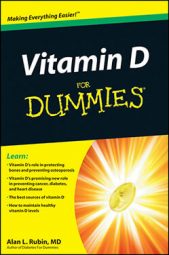Vitamin D may play a role in several brain disorders that cause depression, so is it any surprise that people have looked for a role for vitamin D in depression? Depression, which psychiatrists officially call major depressive disorder, is a mood disorder that varies greatly in its prevalence and severity. Using a broad definition of depression, about 4 percent of men and 8 percent of women will have depression over the course of a year.
Depression symptoms and causes
Depression can occur at any age, but the incidence of this condition begins to increase around age 30. If you’re diagnosed with depression, it means you have five or more of the following symptoms, the first two of which must be present; you also must have the symptoms for at least two weeks:
Decreased interest in most or all activities most of the day, every day
Depressed mood most of the day, every day
Feelings of worthlessness every day
Insomnia or increased need to sleep every day
Loss of energy every day
Restlessness or slowed behavior every day
Significant weight loss or weight gain, or decrease or increase in appetite
Thoughts of death or suicide, or a suicide attempt
Trouble making decisions and concentrating every day
Depression has many causes, including chemical-biological abnormalities in the body, psychological abnormalities, and social factors:
Certain genes may determine whether you respond to life events with depression.
You may have a lack of the chemicals in your brain that lift mood.
Structural abnormalities in the brain can be a cause.
The biological clock may be abnormal, with problems sleeping and staying awake.
Negative psychological responses to life events play a role.
Low socioeconomic status coupled with feelings of hopelessness to change may be important.
Substance abuse such as alcoholism or drug abuse may precede major depression.
Just as depression has many different potential causes, many different treatments are used, from antidepressant drugs to talk therapy or a combination of both. Electroconvulsive therapy, formerly known as shock treatment, has regained some of its favor as a useful treatment for severe depression. Physical exercise can also be helpful if the patient can be induced to exercise.
The prognosis for depression isn’t good. About 3 to 4 percent of patients (many more men than women) commit suicide or die early from some other cause, like heart disease. Most patients have an average of four episodes of major depression during their lives. However, even without any treatment, about 20 percent of patients recover. Each episode of depression lasts a little less than six months.
Vitamin D and depression
It seems fairly clear that if a lack of vitamin D is associated with other diseases that have depression as a central feature, like Alzheimer’s disease and Parkinson’s disease; the same should be true for depression itself. Some evidence for a link between vitamin D and depression includes the following:
Several studies show an association between low serum 25-hydroxyvitamin D levels and depression. For example, women and men with levels of vitamin D below 20 ng/ml or 50 nmol/L were more likely to have depression than those with higher levels. People with serum 25-hydroxyvitamin D levels less that 20 ng/ml or 50 nmol/L were also more likely to develop depression over a six-year follow-up.
Similarly, in a clinical trial of 441 obese and overweight Norwegian people, those with serum 25-hydroxyvitamin D levels less than 16 ng/ml (40 nmol/L) were more likely to be depressed. When these people were then given either a placebo or two high-dose vitamin D interventions (20,000 or 40,000 IU per week), after a year the number of people with depression was lower in the vitamin D groups.
Although not all association studies show a link between serum 25-hydroxyvitamin D and depression, this last study shows how promising the link is. For now, it makes sense to keep your serum 25-hydroxyvitamin D levels over 20 ng/ml (50 nmol/L).

